As part of an ongoing recommitment to its sci-fi genre roots, SyFy Channel is unveiling the original scripted drama Ascension, for now a six hour mini-series, and possible launch for a future series. It follows a crew aboard the starship Ascension, as part of a 1960s mission that sent 600 men, women and children on a 100 year planned voyage to populate a new world. In the midst of political unrest onboard the vessel, the approach of a critical juncture in the mission and the first-ever murder onboard the craft, the audience soon learns, there is more to the mission than meets the eye. Which can also be said of this multi-layered, ambitious, sophisticated mini-series. Full ScriptPhD review below.

Ascension poster and stills ©2014 NBC Universal, all rights reserved.
In the late 1950s and early 1960s, largely fueled by the heigh of Cold War tensions with the Soviet Union and fears of mutual nuclear destruction, the United States government, in conjunction with NASA, launched a project that would have sent 150 people into various corners of space — from the Moon, to Mars and eventually Saturn. Code-named Orion, the project officially launched in 1958 at General Atomics in San Diego under the leadership of nuclear researcher Frederick deHoffman, Los Alamos weapons specialist Theodore Taylor and theoretical physicist Freeman Dyson. Largely fueled by Dyson, Orion’s aim was to build a spacecraft equipped with atomic bombs, that would propel the rocket further and further into space through a series of well-timed explosions (nuclear propulsion). The partial test ban treaty of 1963 ended the grandiose project, which remains classified to this day.
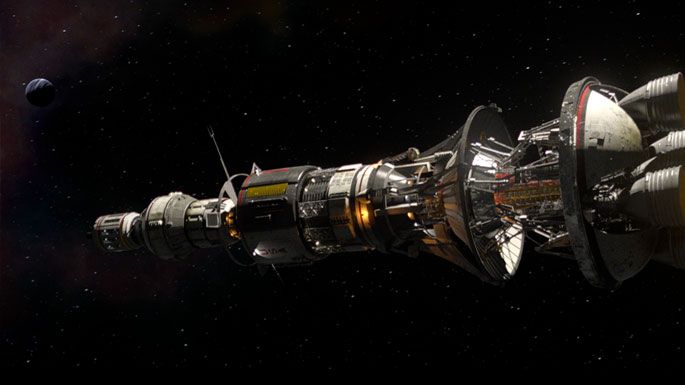
The spacecraft vessel “Ascension” is modeled after NASA reference designs of Project Orion.
Ascension is the seamless fictional transition borne of asking “what if” questions about the erstwhile Project Orion. What if it never ended? What if it was still ongoing? What would be the psychological ramifications of entire generations of people born, raised and living on a closed vessel? Is human habitation of other planets an uncertainty or inevitability? And so Project Orion continued on as Project Ascension, under the hands of Abraham Enzmann. A crew of 600 was sent off into space not knowing the fate of humanity, frozen in time, and as far as they know — all that would be left of mankind.
Ascension carries on in the vein of stylish series such as Caprica, Helix and Defiance, with sleek sci-fi gadgetry and a spaceship capable of mimicking an entire world (including a beach!) for 100 years. This is no dilapidated, aging Battlestar Galactica. However, because time is frozen in the 1960s, all technology, clothes and cultural collections reflect that era — think Mad Men in space. Nostalgia reigns with references to the Space Race via speeches from President Kennedy, along with film and television cornerstones of that era.
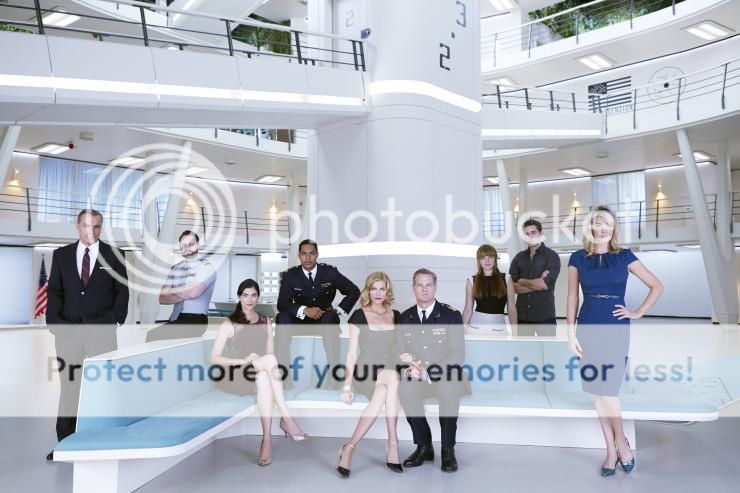
The crew of Ascension aboard their sleek craft.
51 years into the mission, on the evening of the annual launch party celebration, a kind of Ascension independence day, the unthinkable happens: the first ever murder onboard the ship. Captain William Denninger puts first officer Aaron Gault in charge of investigating. Soon, the motives for the murder become convoluted amidst internal politics and the looming “Insurrection,” a point of no return in which communication with Earth is no longer possible.
This year’s space epic Interstellar explored the science of traveling 10 billion light years away from Earth – ambitiously but not without factual fault. And to be sure, Ascension will address the challenges and physics of nuclear propulsion to the far reaches of space, starting with a radiation storm midway through the first episode. But rather than bogging itself down in the astrophysical minutiae of space travel, Ascension smartly focuses on the human drama and existential questions such a voyage would incur, precisely what made Battlestar Galactica such compelling sci-fi television. Would there be internal psychological ramifications to this journey? All residents of the ship seem to go through an adolescent period termed “The Crisis,” where they come to grips with the fact that they have no future, and a pre-determined fate. Furthermore, the murder victim’s young sister appears to be a “seer” with telekinetic insight into the nefarious inner workings of the ship.
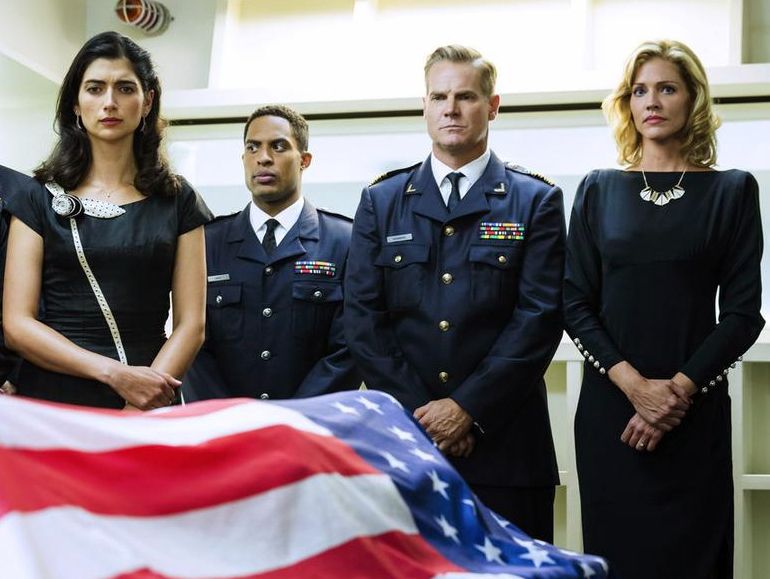
The Ascension crew, and victim’s sister, mourn the first-ever death aboard the ship in a scene from “Ascension.”
Would there be class division and political turmoil aboard such a confined community? There is a decidedly troublesome rift between the ranking officers of the upper quarters and the “Below Deckers”: butchers, steelworkers and other blue-collar craftsmen that appear on the edge of a revolt. Compounding their efforts are the Captain’s wife, Viondra Denninger (whom fans will recognize as Cylon Number Six from BSG), a cunning, manipulative power broker and the man seeking to wrestle control of the ship from her husband. Back on Earth, we meet Harris Enzmann, the son of the dying Project Ascension founder. Seemingly a low level government engineer, nor remotely interested in preserving his father’s legacy, his role in Project Ascension is convoluted yet significant.
Project Ascension is indeed an experiment critical for human survival — just not the one anyone onboard thinks it is. Amidst an awakened collective imagination about space exploration, including 2015′s IMAX Mars mission movie Journey To Space, this is one sci-fi mission worth taking.
View a trailer for Ascension:
Ascension is a three-day mini-series event on SyFy Channel, beginning Monday, December 15.
~*ScriptPhD*~
*****************
ScriptPhD.com covers science and technology in entertainment, media and advertising. Hire us for creative content development.
Subscribe to free email notifications of new posts on our home page.
]]>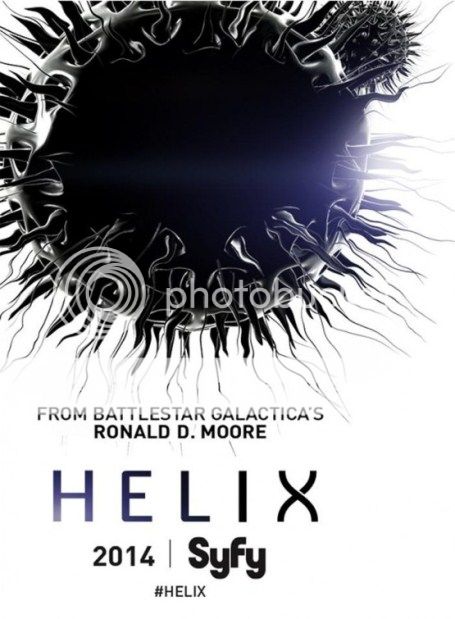
Helix poster and stills ©2014 NBC Universal, all rights reserved.
The biggest threat to mankind may not end up being an enormous weapon; in fact, it might be too small to visualize without a microscope. Between global interconnectedness and instant travel, the age of genomic manipulation, and ever-emerging infectious disease possibilities, our biggest fears should be rooted in global health and bioterrorism. We got a recent taste of this with Stephen Soderberg’s academic, sterile 2011 film Contagion. Helix, a brilliant new sci-fi thriller from Battlestar Galactica creator Ronald D. Moore, isn’t overly concerned with whether the audience knows the difference between antivirals and a retrovirus or heavy-handed attempts at replicating laboratory experiments and epidemiology lectures. What it does do is explore infectious disease outbreak and bioterrorism in the greater context of global health and medicine in a visceral, visually chilling way. In the world of Helix, it’s not a matter of if, just when… and what we do about it after the fact. ScriptPhD.com reviews the first three episodes under the “continue reading” cut.
The benign opening scenes of Helix take place virtually every day at the Centers for Disease Control, along with global health centers all over the world. Dr. Alan Farragut, leader of a CDC outbreak team, is assembling and training a group of researchers to investigate a possible viral outbreak at a remote research called Arctic Biosystems. Tucked away in Antarctica under extreme working conditions, and completely removed from international oversight, the self-contained building employs 106 scientists from 35 countries. One of these scientists, Dr. Peter Farragut, is not only Alan’s brother but also appears to be Patient Zero.

CDC researcher Dr. Sarah Jordan uncovers a victim of the Narvic A virus in a scene
from “Helix.”
It doesn’t take the newly assembled team long to discover that all is not as it seems at Arctic Biosystems. Deceipt and evasiveness from the staff lead to the discovery of a frightening web of animal research, uncovering the tip of an iceberg of ‘pseudoscience’ experimentation that may have led to the viral outbreak, among other dangers. The mysterious Dr. Hiroshi Hatake, the head of Ilaria Corporation, which runs the facility, may have nefarious motivations, yet is desperately reliant on the CDC researchers to contain the situation. The involvement of the US Army engineers and scientists, culminating in a shocking, devastating ending to the third episode, hints that the CDC doesn’t think the outbreak was accidental. Most frightening of all is the discovery of two separate strains of the virus, Narvic A and Narvic B, the former of which turns victims into a bag of Ebola-like hemorrhagic black sludge, while the latter rewires the brain to create superhuman strength – a perfect contagion machine.
With some pretty brilliant sci-fi minds orchestrating the series, including Moore, Lost alum Steven Maeda and Contact producer Lynda Obst, it’s not surprising that Helix extrapolates extremely accurate and salient themes facing today’s scientific environment. Spot on is the friction between communication and collaboration between the agencies depicted on the show – the CDC, bioengineers from the US Army and the fictional Arctic Biosystems research facility. In reality, identifying and curtailing emerging infectious disease outbreaks requires a network of collaboration among, chiefly, the World Health Organization, the CDC, the US Army Medical Research Institute of Infectious Diseases (USAMRIID, famously portrayed in the film Outbreak) and local medical, research and epidemiological outposts at the outbreak site(s). In addition to managing egos, agencies must quickly share proprietary data and balance global oversight (WHO) with local and federal juristictions, which can be a challenge even under ordinary conditions. To that extent, including a revised set of international health regulations in 2005 and the establishment of an official highly transimissible form of the virus created a hailstorm of controversy. In addition to a publishing moratorium of 60 days and censorship of key data, debate raged on the necessity of publishing the findings at all from a national security standpoint and the benefit to risk value of such “dual-use” research. Similar fears of “playing God” were stoked after the creation of a fully synthetic cell by J. Craig Venter and the team behind the Genome Project.

Arctic Biosystems head Dr. Hiroshi Hatake and his security head Daniel Aerov watch over CDC Dr. Alan Farragut, sealed off in a Biosafety Level 4 laboratory in a scene from “Helix.”
As with Moore’s other SyFy series, Battlestar Galactica, Helix is not perfect, and will need time and patience (from both the network and viewing audience) to strike the right chemistry and develop evenness in its storytelling. The dialogue feels forced at times, particularly among the lead characters and with rapid fire high-level scientific jargon, of which there is a surprising amount. Certain scenes involving the gruesomeness of the viruses feel too long and repetitive in the first episodes, but this will quickly dissipate as the plot develops. But for all of its minor blemishes, Helix is one of the smartest scientific premises to hit television in recent times, and looks to deftly explore familiar sci-fi themes of bioengineering ethics and the risks of ‘playing God’ just because we have the technology to do so.
We’ve become accustomed to sci-fi terrifying us visually, such as the ‘walker’ zombies of The Walking Dead or even psychologically, as in the recent hit movie Gravity. But Helix’s terror is drawn from the utter plausibility of the scenario it presents.
View an extended 15 minute sample of the Helix pilot here:
Helix will air on Friday nights at 10:00 PM ET/PT on SyFy channel.
~*ScriptPhD*~
*****************
ScriptPhD.com covers science and technology in entertainment, media and advertising. Hire us for creative content development.
Subscribe to free email notifications of new posts on our home page.
]]>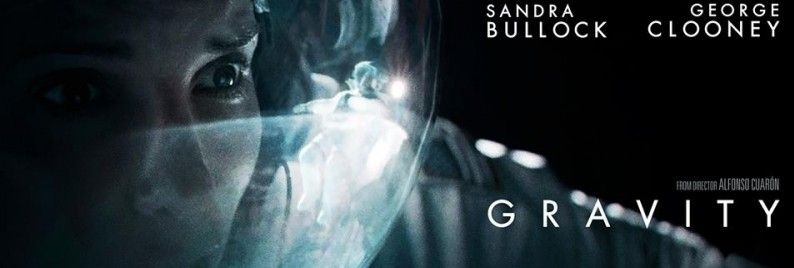
Gravity poster and stills ©2013 Warner Brothers Pictures, all rights reserved.
Space movies are almost always grandiose in their storytelling aspirations. The enormity of space, the raw power of the shuttle, the existential quandary of whether we are alone in a vast Universe, and (as is the case in Gravity) an almost-inevitable crisis that must be resolved to steer the astronauts onboard to safety. There is one critical detail, however, that most fail to convey visually—solitude. Dr. Katherine Coleman, who spent thousands of hours aboard the shuttles Columbia and the International Space Station, and who was a primary mentor to star Sandra Bullock, recounts isolation—spatial separation, physical movements, zero gravity and a distant Earth—as the biggest challenge and reward she faced as an astronaut. With a tense, highly focused storyline centered almost entirely on one brave scientist, Gravity is a virtual space flight for the audience, but also a gripping examination of emotional and physical sequestration. Through this vista, we are able to perceive how beautiful, terrifying and enormous space truly is. Full ScriptPhD.com Gravity review under the “continue reading” cut.
It is in this backdrop that we are first introduced to Mission Specialist Ryan Stone (Bullock), a medical engineer turned novice astronaut sent to repair an arm of the Hubble Telescope, and ebullient, assertive veteran Mission Commander Matt Kowalski (Clooney), out on his last voyage in space. During a routine scanning system installation on the exterior of their shuttle, an intentional demolition of an obsolete satellite sends shrapnel debris unexpectedly hurling through space right in their direction. This nightmare scenario, called the Ablation Cascade, was first hypothesized back in 1978 by NASA scientist Donald J. Kessler. Once the density of objects flying in low Earth orbit became high enough (everything from space junk to satellites to intergalactic matter), a collision between two of those objects would lead to further collisions with other nearby objects, each creating more dangerous debris hurling through space. With catastrophic damage to their shuttle, Kowalski and Ryan are the sole survivors with no access to NASA Mission Control and no ability to steer their shuttle home. Limited oxygen supply and a series of tragic consequences soon leave the two astronauts to survival instincts and a last-ditch escape via an international space station as their only hope for returning to Earth.
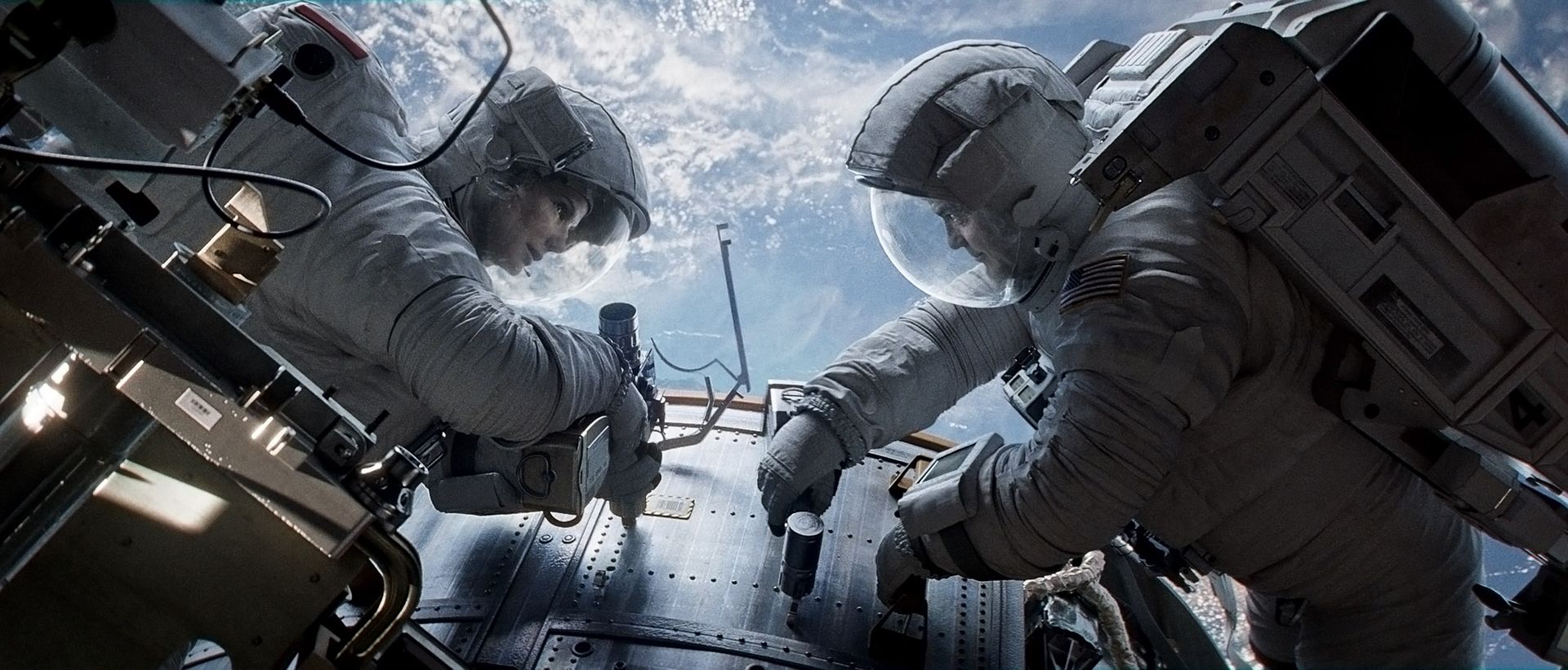
Dr. Ryan Stone (Bullock) and Astronaut Matt Kowalski (Clooney) working on their shuttle before a catastrophic accident moors them alone in space.
Much like its smart 2013 predecessor, Europa Report, Gravity is a highly technical, pinpoint-accurate movie that relied on input from NASA astronauts and physicists for every level of execution. Director Alfonso Cuarón, working on his first big screen film in seven years, worked painstakingly alongside a talented crew to implement previously-unproven digital technologies aimed at transporting audiences into weightless space.
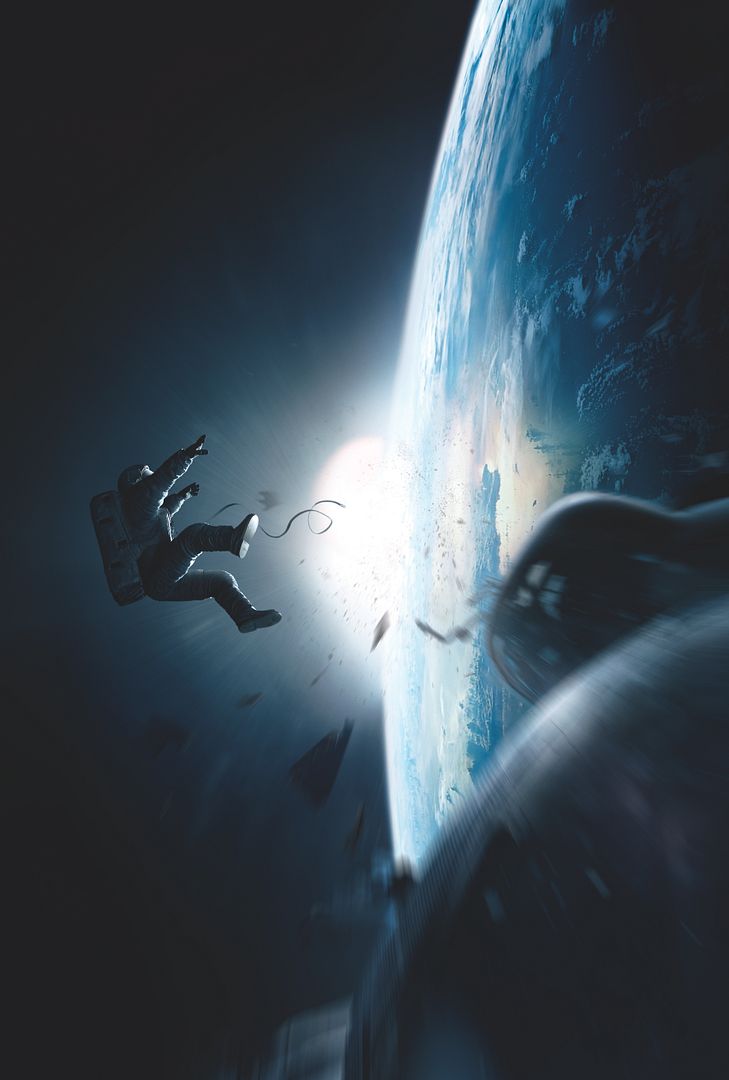
Hold on tight! The jarring view from Dr. Ryan Stone’s (Bullock) helmet of a drifting colleague fighting incoming debris as they both try to stay tethered to their shuttle.
Dr. Michael Massimino, a Hubble service specialist with missions on Space Shuttles Columbia and Atlantis, provided insight into space travel and space walking. In addition, Clooney and Bullock spent hours training for zero gravity conditions, while artistic directors and technical crew built special stage-size light boxes and green screens to be able to create remarkable CGI renderings of space from all angles. “Even if [Gravity] was a work of fiction,” Cuarón remarked at a recent screening preview, “We wanted everything, especially the physics of space, to be as accurate as possible.”
Despite the thrilling story and technical fidelity, there is a stylistic beauty to Gravity rooted in simplicity, a silent abyss in the midst of intergalactic chaos. Cuarón’s desire to showcase space as a central physical and thematic piece of his movie is reflected in every frame. He perceived Gravity to be an existential film about “a woman drifting into the void and confronting adversity.” Rather than being tethered to the constraints of a time and place, however, the solar elements of space are the surge of life that inspires her to keep going.
“I used to think that astronauts wanted to go into space for the thrill and adventure,” Bullock reflected. “When I spoke to them, though, I was so moved by their deep love of that world and the beauty of Earth from their perspective. It’s amazing to realize how small we are in this massive universe.” These are the very details that are magnified on screen as the story unfolds – a tiny human being drifting in the enormity of space, a comforting human voice on the radio amid total abyss, a teardrop defying gravity, the magic of another sunrise viewed from millions of miles away.
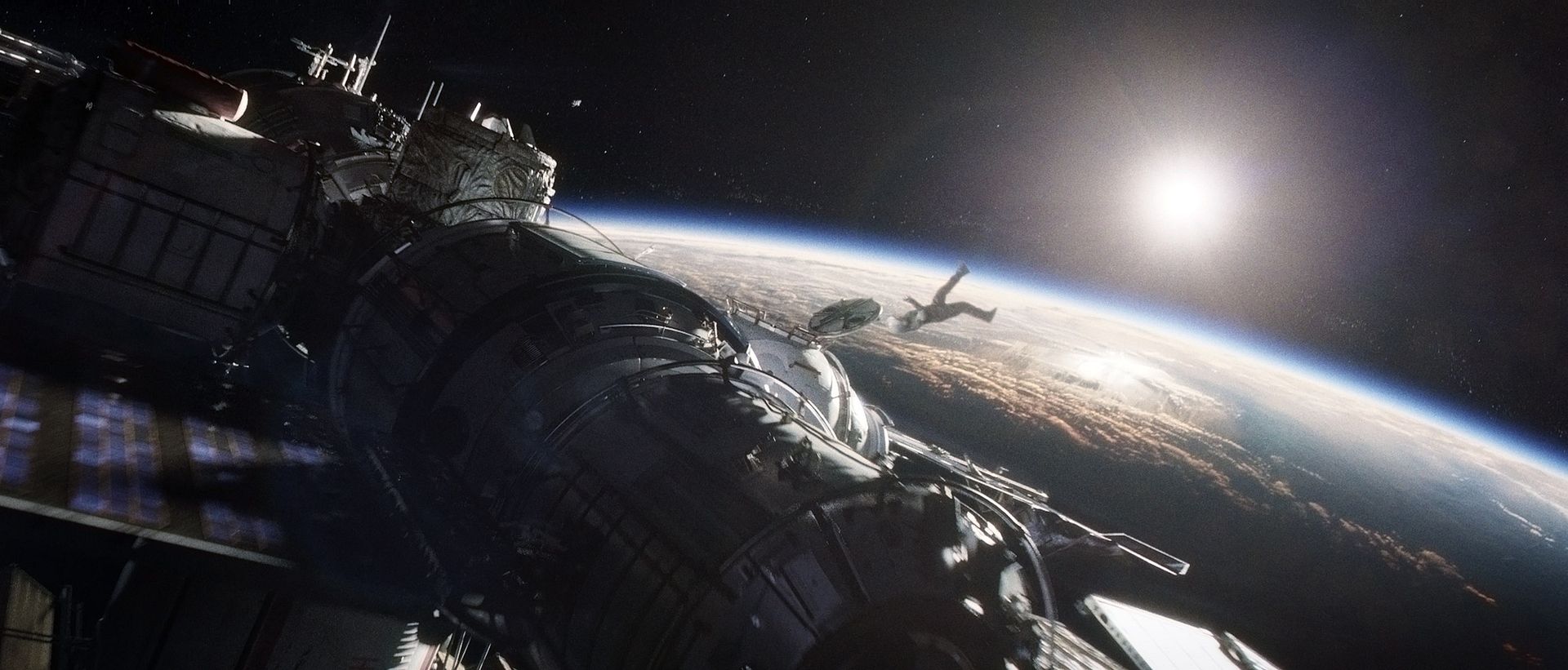
Earth, as viewed from the space shuttle by an astronaut in a scene from “Gravity.”
Far more than just a creative interpretation of space, Gravity is that rare piece of art that can inspire and entertain, a true game-changer in a crowded space film genre. As Dr. Massimino emotionally reminded the press during the preview screening, centers like NASA and the Jet Propulsion Laboratory in Pasadena, CA are still doing important research as part of a space program that is very much thriving and as critical as it has ever been. Gravity is a magical way to bring the masses into space and inspire a new generation of support for NASA. “This movie will make folks understand what we do and why it is so important,” Massimino hopes.
As a love letter to space exploration and the sheer strength of human tenacity, Gravity exceeds all expectations.
Gravity goes into wide release in theaters and IMAX on October 4, 2013.
View an extended Gravity trailer:
~*ScriptPhD*~
*****************
ScriptPhD.com covers science and technology in entertainment, media and advertising. Hire us for creative content development.
Subscribe to free email notifications of new posts on our home page.
]]>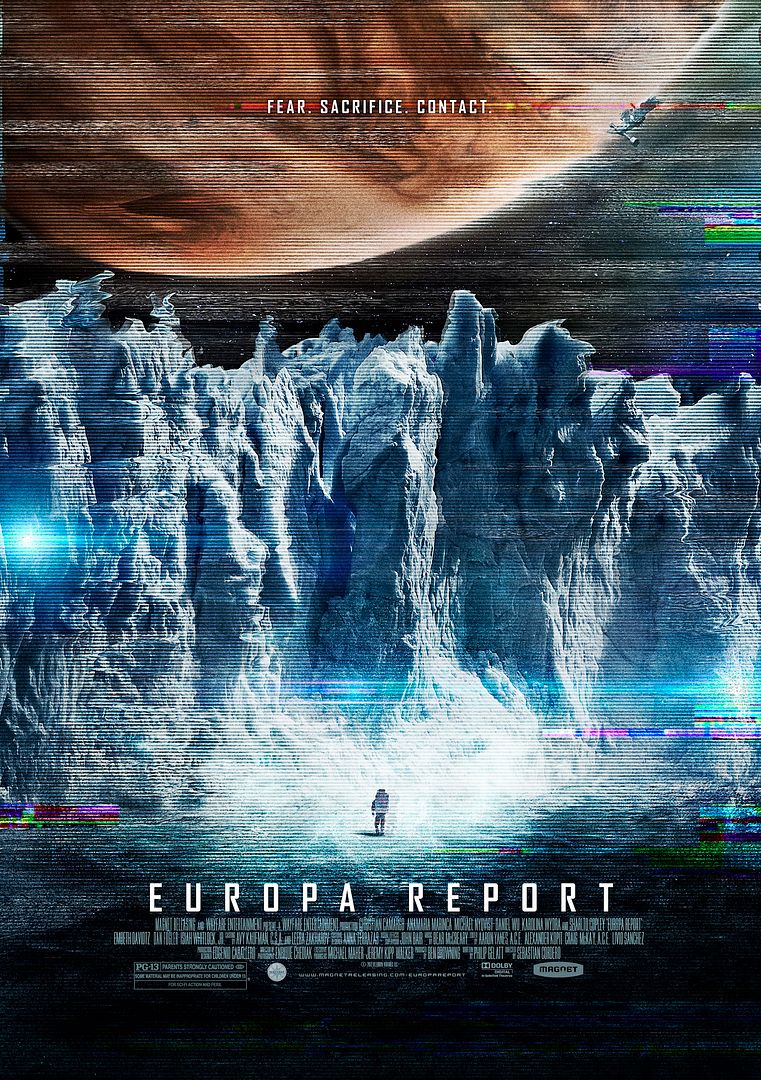
Europa Report poster and stills ©2013 Magnolia Pictures, all rights reserved.
In 2007, new NASA research suggested that underneath the vast ice sheaths of Jupiter’s moon Europa lay oceanic water, which is a key element to support life. The Galileo probe, which had been orbiting the moons of Jupiter since December of 1995, was constantly orbiting and swooshing near the sixth largest moon in the solar system, collecting pictures and data that could prove the existence of liquid water. Then in 2011, scientists hit a proverbial jackpot—evidence for two liquid lakes the volume of the North American Great Lakes underneath a region of jumbled ice blocks termed the ‘Conamara Chaos.’ Even in the wake of such exciting discoveries, critical budget cuts severely threatened NASA’s space program, including the Mars rover and Cassini spacecraft orbiting Saturn. This same time frame gave concurrent rise to private space travel, led by the commercial venture Virgin Galactic and ambitious research company Space X. The merger of limitless industry resources with the possibility of uncovering alien life seems like a perfect Hollywood pitch. Such is the scenario explored in the brilliant documentary-style sci-fi thriller Europa Report. A full ScriptPhD review under the “continue reading” cut.
First conceptualized in 2009, prior to NASA’s landmark discovery of Jupiter’s large lakes, Europa Report explores the fundamental question driving space discovery: “Are we alone?” With private funds and advanced technology at their disposal, the fictitious Europa Ventures space exploration company enlists seven brilliant voyagers for the groundbreaking “Europa Mission,” the first venture beyond Earth’s orbit since 1972. Masterminded by company founders Drs. Samantha Unger and Tarik Pamuk, who also narrate the film and drive the story forward in current time, the multi-year investigative mission (16 months on Europa alone!) would combine state-of-the-art science with modern entertainment. Europa Report’s first act parlays the mundane lull of life in space—exercise to stave off atrophy, recycling urine for distilled water, ship engineers Andrei Blok and James Corrigan bickering in close quarters—overshadowed by the hints of future tragedy.
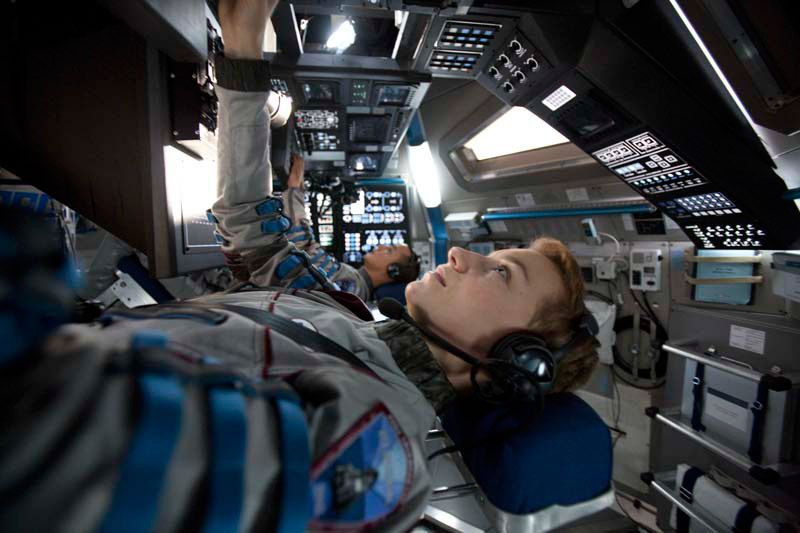
Crew members guide a spacecraft on a mission to observe possible life on Europa in a scene from the film “Europa Report.”
Indeed, approximately six months into their journey, the Europa Mission communications with ground control are cut off by an unexpected solar storm. From here, the film cleverly seesaws between the present and chronological flashbacks, as the crew bravely decides to press on with their journey. The film’s tempo subtlely, but effectively, picks up with a series of tragic events that affect the crew. When the ship is stranded on the moon’s surface due to heat beneath the ice surface, the crew take drastic steps, led by pilot Rosa Dasque to ensure that the precious data they collected is not for naught.
Europa Report is easily the most realistic depiction of travel and life in space since 2009’s Moon and the 1960s standard-bearer 2001: A Space Odyssey. Committed to the accuracy of its sets, shuttle, space imagery and scientific data, Europa Report relied on heavy consultation with NASA/Jet Propulsion Laboratory, SpaceX and other scientific leaders from the planning and execution of the mission to what the surface of Europa would look like. Filmmakers worked with astrobiologists to conceive theoretical, yet plausible, Europa life forms from the bioluminescent ones that exist deep in the Earth’s oceans. The depiction of the Europa landing is one of the most exciting science movie moments I have ever seen on screen.
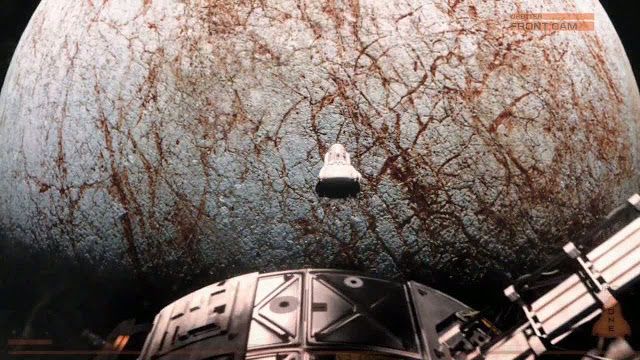
A view of Jupiter’s moon Europa during a scene from film “Europa Report.” Collaborations with NASA allowed filmmakers to provide as much scientific accuracy as possible.
With the help of NASA and SpaceX, set designer Eugenio Caballero built a fully authentic spaceship, including living quarters, control area and zero gravity wirework. After production was complete, the visual effects team replicated the Europa exterior environment based on data and imagery collected during the Galileo mission. Perhaps as a result, some of the film’s strongest sequences occur when Dr. Katya Petrovna tenuously ventures on the icy surface to collect data and explore the surroundings, leading to the heart-stopping conclusion that both seals the team’s ultimate fate and reaffirms the value of their mission.
“This project felt like a unique opportunity to do something plausible but forward thinking, somewhere between NASA and Star Trek,” said Ben Browning, whose company Wayfare Entertainment developed the film.
Europa Report is constructed to feel like a documentary or voyeuristic web stream of a very real (and altogether possible) scientific experiment. That a reality show would be borne of such an undertaking is a foregone conclusion. Nevertheless, the film leaves several important overarching existential questions that we must examine in our inevitable quest to search the galaxy for extra-terrestrial life. Even if we find life forms in the outer galaxy, do we really want to know what’s out there? Or perturb it? In the case of Europa Report, a terrifying conclusion conjures up as many fears as it answers exciting possibilities. Secondly, as technology makes extreme space travel to previously-unreached distances possible, we must never forget the element of danger that fuels the bravery of the astronauts and scientist that
undertake these endeavors. Lastly, is the commercialization of space a good idea? In the wake of celebrities buying shuttle rides into Earth’s orbit and space ventures funded by billionaires, who will maintain regulatory oversight and scientific integrity?
Ultimately, it’s inevitable that there will be a real-life mission to Europa, or even beyond. And an even bigger possibility that a groundbreaking discovery of current life in outer space will be made. But until that day, Europa Report unveils a grand science experiment before our eyes and perhaps, even a glimpse into the future.
View a trailer for Europa Report:
Europa Report goes into limited theatrical release on August 2, 2013 and is available On Demand.
~*ScriptPhD*~
*****************
ScriptPhD.com covers science and technology in entertainment, media and advertising. Hire our consulting company for creative content development.
Subscribe to free email notifications of new posts on our home page.
]]>
Defiance television show and video game images are ©2013 NBC Universal. All rights reserved.
SyFy channel’s new show Defiance is breaking the mold in every way. An unusual combination of fantasy blockbuster, small town mystery and sci-fi action drama, Defiance takes place on a decimated, post-apocalyptic Earth set several decades into the future. After an alien invasion and war, hmans try to co-exist with a group of aliens that are both friend and foe in a small town literally defying the odds. ScriptPhD.com was extremely fortunate to have access to one of the head writers of the show, as well as its official science advisor. In our interviews, we delve deeper into the backbone of this sci-fi hit, which is a terrific, engaging story, paired with colorful characters and the clever incorporation of science to support the plot. More after the “continue reading” cut.
Defiance is set amidst a backdrop of the ruins of a major American city, formerly St. Louis, now called Defiance, where a group of humans and aliens must survive under extreme political and existential circumstances. Jeb Nolan, a former military hero who fought the last battle of the human-Votan war, aptly named the Battle of Defiance, is now a wanderer looking for his place in the world. His adopted daughter Irisa, from a Votan alien tribe called the Castathans, is also battling a difficult past as she migrates between the world of her own people as friends and foes. In the middle of episodic mysteries, such as who is behind an attack on Defiance, or the murder mystery of the town mining magnate’s son, is a larger storyline about the integration of human and alien races in a unique post-apocalyptic melting pot.
For the SyFy channel, Defiance looks like the first bona fide hit since Battlestar Galactica, whose prequel follow-up Caprica never managed to latch on with a consistent audience. It’s premiere had the highest ratings since Eureka and follow up episodes are holding a steady audience.
And if its intricate plot isn’t enough to keep viewers hooked, Defiance is defying traditional media by merging the show with a concomitant multiplayer online video game concept, where action takes place simultaneously in San Francisco. The events that take place in the video game, which has already recorded one million registered users, will impact the storyline of the show to varying degrees, and vice versa. It is without a doubt the most interactive and ambitious storytelling format ever attempted for the genre from a technical standpoint.
ScriptPhD.com was very honored to have the opportunity to sit down with both series writer and co-creator and executive producer Michael Taylor, as well as the show’s scientific advisor Kevin Grazier, to get a better idea of the characters, storyline and what we can expect going forward.

A couple of the Votan races represented on Defiance: the Indigenes (the town doctor on the left) and Castathans (Irisa, one of the principal characters).
Taylor, also a series writer and producer on breakout SyFy hit series Battlestar Galactica, was involved in the early development of the series, which took over one and a half years to re-conceptualize and bring to the small screen from its initial concept. “Keep in mind, the original draft [of the pilot] was very different,” Taylor says. “The Chief Lawkeeper role was prototyped as this older, wry Brian Dennehy-type of character, for example. Irathient warrior Irisa was more of a wide-eyed, naïve girl than she is in the current version. We even had about two to three episodes of the series done. But as we went along, we were finding it hard to keep thinking up episodes from week to week.” Which is when the series went back to the drawing boards.
And reimagine the series they did! Unlike the vast majority of sci-fi shows, which explore the process of warring factions integrating and co-existing, in Defiance, this has already occurred, something that Taylor calls a “cool experiment.” “The 30-year-war has already been fought, all that stuff is long in the past,” Taylor reminds us. “And now we are at the point where the 8 races are trying to co-exist together. Remember, in the opening episode, the mayor [Amanda Rosewater] tells the multi-ethnic crowd that Defiance is a pretty nice place to live.” Which is in stark contrast to the vast majority of the now-destroyed Earth, which remains a very dangerous, primitive environment, as is seen in the opening minutes of the pilot. But the relatively peaceful, self-contained environment of Defiance is not the only way it differs. “This idea of the 8 races living together is still pretty rare [throughout Earth],” Taylor remarks. “In fact, in Rio de Janeiro you have the opposite with the Votan-led Earth Republic, which has pretty much the
opposite goal than what’s happening in Defiance.”
People should also be careful about inferring too many sociological or current events extrapolations from the themes explored in the show. For Taylor, the writers and creators are mainly exploring a fun concept with strong storytelling and even stronger characters. And what characters they are!
Lawkeeper Jeb Nolan and his adopted daughter Irisa are both dark, complex characters with extremely difficult pasts. “In many ways, they complement each other and need each other,” Taylor says. “They are the only two people who can complete one another because of that bond.” But they aren’t the only characters with a past. New young mayor Amanda herself has some dark secrets that fuel her motivations, many of which will be explored in future episodes, according to Taylor. At the mere suggestion that mysterious ex-mayor Nicky, who figures into the Votan plot against the humans, might not be that evil, Taylor retorts: “Nope, she’s evil. She just rationalizes her actions as the end justifying the means.”
As for integrating the video game concept, it predated the show by five years, which allowed writers to establish stories and character development that will happen separately from, albeit concurrently with, the action in Defiance onscreen. It also affords the writers on the show some freedom with the knowledge that the events in the video game don’t necessarily impact the flow of the storyline right away. “With the production schedule of television, there’s no way that we would be able to incorporate plots from the video game into the show that quickly,” says Taylor. “But remember, there is a summer hiatus between seasons, so you never know. Maybe that would be a time the writers would be able to look at some of the events that gamers chose and fold them into the story with more leisure.”
So rest assured, those of you enjoying Defiance, whether on your televisions or XBoxes. Plenty of sci-fi action is yet to come.

A scene from the Defiance interactive video game.
In case viewers are worried that Defiance’s deep focus on character development and storyline layout (in two media formats no less!) is going to come at the expense of accurate and interesting science, fear not. The production staff at the sci-fi hit has employed the services of notable scientific advisor Kevin Grazier, who also advised on Eureka and Battlestar Galactica, along with a slew of feature films.
“We’ve seen time and time again small plot points that have become little tidbits, or plot points or even major points driving an episode when you get the science right,” Grazier notes. “Caring about the science [in a series plot] can be as much of a strength as it is a constraint.”
And while it’s true that the science of Defiance does seem a bit less obvious or upfront than in shows like BSG or Eureka, it’s no less important nor is it any less incorporated. “We have a really rich, really well thought-out backstory, and that is very much informed by the science,” Grazier says. “We know that the V-7 [Votan] races came from the Votan System. What happened to their system? Well, we have that [mapped out], we know that.” He also pointed to subtle implications such as in the first few minutes of the pilot. When Irisa looks up at the sleeper pods, she says, “All those hundreds of years in space just to die in your sleep.” Grazier notes: “The subtle implication is that the V-7 aliens don’t go FTL [faster than light]. So we have figured out where they’re from and how far away they’re from and which direction of the sky they’re from and how long it took to get here.”
In addition to its elemental role in the backstory, science has also also had fun ‘little’ moments in the show, like the importance of the terrasphere in defending the Volge attack in the pilot or the hell bugs (a genetic amalgam of several earth critters) in episode 3. Some of these small scientific details were even able to result in cool visual effects. For example, when the table of writers was discussing the ark falls, Grazier, an astrophysicist by training, noted that the conservation of angular momentum meant that these things would not land vertically, but rather horizontally, using the screaming overhead comets in Deep Impact as a touchstone. Sure enough, in the first few minutes, you see Nolan and Irisa tracking what’s about to be an ark fall and you see them screaming overhead. “That will, by the way, come into play in a later episode,” Grazier teases. “We know where the ark belt is. Where the ships were when they blew up, how far away they are.”
For Grazier, the experience has not only been a rewarding one, but different from the other shows he’s worked on. “Just to give you an example of how great the Defiance writing team is with regards to the science, in an upcoming episode, the writers had written a script and there was a big incident in there that I said “You can’t do this scientifically.”" Grazier kept shooting down suggestion after suggestion, with series producer Kevin Murphy, who was a huge Basttlestar Galactica fan, staying patient and open to ideas despite being frustrated by the process. In the end, the series producers allowed Grazier to provide input to the plot that both worked scientifically and resulted in decent storytelling and visual effects. “There was a situation that the scientific content was a sticking point, and a fairly major element of the plot, and they let the science guy come up with the solution,” he remarked. “As satisfying as some of the other series that I’ve worked on have been, that’s never happened to me before.”
“Obviously in any sci-fi show, there are going to be a few [unrealistic] gimmes, a few conceits for the sake of the plot or entertainment,” Grazier reminds us. “But if you buy in that these terrashperes came down and transformed the Earth and take this journey with us, then the science will take you the rest of the way.”
Based on the first three episodes, it’s a journey I know is worth the ride.
Watch a feature-length trailer for the show here:
Watch a special video about the making of the Defiance
Defiance airs on Monday nights on SyFy Channel at 9 ET/PT.
~*ScriptPhD*~
*****************
ScriptPhD.com covers science and technology in entertainment, media and advertising. Hire our consulting company for creative content development.
Subscribe to free email notifications of new posts on our home page.
]]>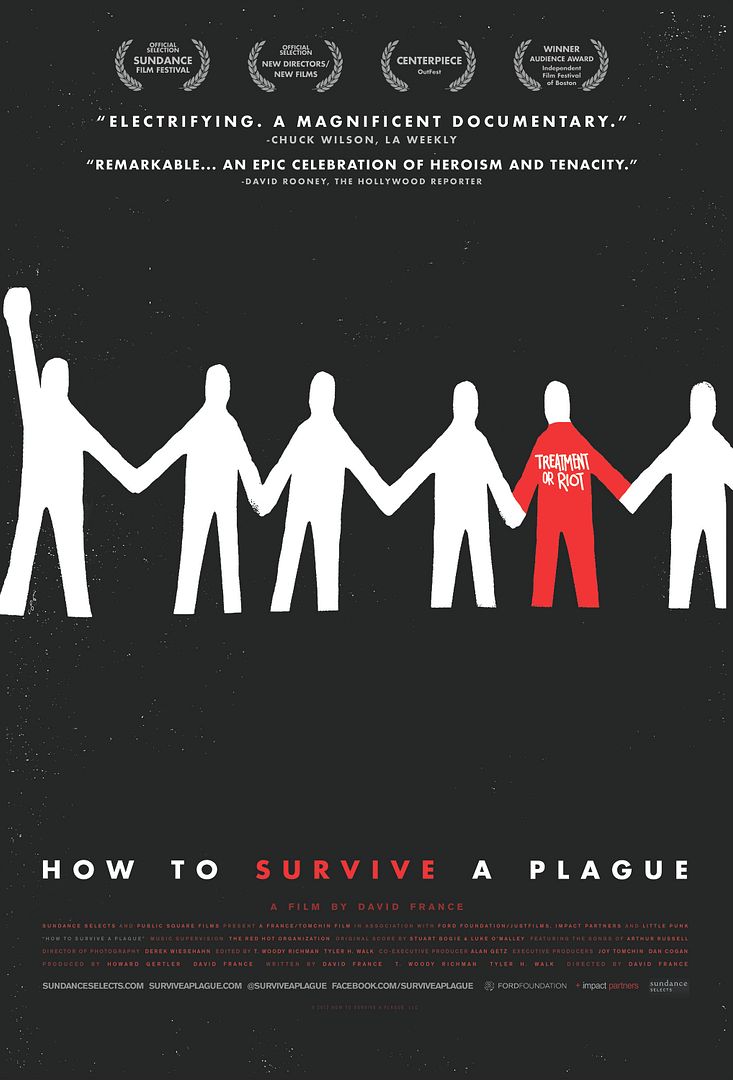
How To Survive a Plague film poster and stills ©2013 Public Square Films, all rights reserved.
The history of science movies nominated for Oscars is not a very long one. Aside from the technical achievement awards or an occasional nomination for acting merits, the Best Picture category has historically not opened its doors to scientific content, save for notable nominees “A Clockwork Orange,” “District 9,” “Inception” and “Avatar.” A documentary about science has never been nominated for the Best Documentary category, until this year, with How To Survive a Plague, Director David France’s stunning account of the brave activists that brought the AIDS epidemic to the attention of the government and science community in the disease’s darkest early days. “Plague” set history last weekend by becoming the first “Best Documentary” nominee with an almost entirely scientific/biomedical narrative. More importantly, it also established a standard by which future science documentaries should use emotional storytelling to captivate audiences and inspire action. ScriptPhD review and discussion under the “continue reading” cut.
“How To Survive a Plague” picks up where groundbreaking companion AIDS film “And the Band Played On” drops off, around 1987, with the formation of the AIDS Coalition to Unleash Power (ACT UP) advocacy group, which is the central protagonist of the documentary. The AIDS virus had been identified, isolated and diagnosed in patients. But as a running ticker throughout the movie reminds us, the AIDS death toll knew no limit. By 1988, 70,000 people had already perished, a number that would climb to an astonishing 500,000 by 1997. Complacency and frustration were the norm among medical professionals, who treated patients with a series of “what the hell” drugs, when they’d even consider treating them. The scientific community, although recognizing that research was necessary, devoted little money or manpower. Even early drugs that showed experimental efficacy or relieved symptoms in AIDS patients were dismissed.
Scientists and the government were the targets of ACT UP’s fury and protests.

ACT UP founding member Peter Staley impassioned during an arrest at a protest.
But by the late 80s/early 90s, ACT UP’s mission had reached a critical Phase II: conformity. Extremists and truculent zealots were dismissed to the sidelines, while the group became self-made scientists, learning everything from medicine to virology and immunology to chemistry. Rather than shut down the FDA for a day like they’d done years ago, they showed up to a scientific meeting in suits and ties to hand out a well-thought-out publication worthy proposal on AIDS research and treatment timelines. Impressed scientists took note. By the time charming ACT UP leader Peter Staley addresses an international convention meeting of the American Society for Microbiology, he is given a standing ovation. ACT UP’s fight, the fight of the gay community, had now become a global fight.
In many ways, “How To Survive a Plague” is an emotional contrast to “And the Band Played On,” even though the former is a documentary largely consisting of reel footage of the events it portrays, while the latter is a dramatized account of scientists racing to find the identity of the AIDS virus. Although “Band” touches briefly on the fear, government insouciance and distrust within the gay community in the earliest days of the bourgeoning epidemic, it is very much a pure science film. Its themes of persistence, no-holds-barred competition, stunningly accurate epidemiology and virology details and race to an answer could be about any virus in any historical time. “Plague” puts all of the science and medicine of the AIDS crisis in an emotional and historical context. A running death ticker as the years pass lends an urgency to the battle of the ACT UP activists. Moreover, France inserts actual footage of their protests (the most famous being an all-day takeover of the National Institutes of Health), meetings and press conferences, and difficult-to-watch footage of AIDS that shines an intimate spotlight of realism on the crisis. As France notes, the AIDS crisis burgeoned concomitantly with the appearance of the camcorder, making early AIDS activists “the very first social movement to shoot a world the dominant culture was ignoring.”

ACT UP activists stage a successful takeover of the National Institutes of Health infectious diseases division (NIAID) in May of 1990 to bring attention to the dearth of funding for researching new AIDS medications.
Scientists in the movie range from heroes and anti-heroes to ordinary people, which is a rarity in entertainment media. By far the biggest hero is Dr. Iris Long, a chemist with 20 years of experience in retroviral drug development. Although she knew no one with AIDS and never met a homosexual in her life, Dr. Long became a mentor and science advisor to ACT UP. Her fearless leadership and ability to educate the members led to direct reforms at the FDA and NIH. Other members like Bill Bahlman (the first to demand a direct drug treatment for AIDS) and Garance Franke-Ruta (a high school drop out and science nerd who became the group’s leading advocate for science-based activism) led the internal change to join forces with scientists rather than fighting them. And for every scientist that ignored the AIDS crisis was a research pioneer like Anthony Faucci, now head of the NIH Institute of Allergy and Infectious Disease, or a Merck chemist leading the development of anti-retroviral drugs. Moments after a graphics-filled technical explanation of how anti-retroviral drugs inhibit HIV virus replication, one of the Merck scientists interviewed in the film broke down into tears when recollecting the enormity of what they’d accomplished. It’s a stunning, raw moment in a film filled with them. Recent advances in writing for sci-fi have painted more complex, human depictions of scientists and researchers. But such insights are far too rare in documentaries.
In a strangely macabre way, “Plague” is an emotional feel good story, but one that isn’t over yet. Through the darkest days of rallying a tone-deaf world, all the while losing members day by day, ACT UP’s commitment and perseverance never failed. By the time surviving members, some of whom professed in footage that they never expected to live, are finally revealed in the present day in the film’s last act, the audience is flooded with gratitude and catharsis. The science world, which once didn’t know what to make of this emerging virus, took only one year from the time the first protease inhibitor hit the market to come up with and approve the current three-drug treatment cocktail.
But the film’s unstated, looming conclusion is that we will never get back the millions of people who died during a decade of silence. Too many people continue to perish, most in what has become a new frontier for the AIDS crisis. The fight for a cure or prevention is not over. And a new plague could always be around the corner. It is our hope that future documentarians take note of both the film’s message and its delivery style.
Take a look at the official trailer for “How To Survive a Plague”:
~*ScriptPhD*~
*****************
ScriptPhD.com covers science and technology in entertainment, media and advertising. Hire our consulting company for creative content development.
Subscribe to free email notifications of new posts on our home page.
]]>
For every friendly robot we see in science fiction such as Star Wars’s C3PO, there are others with a more sinister reputation that you can find in films such as I, Robot. Most movie robots can indeed be classified into a range of archetypes and purposes. Science boffins at Cambridge University have taken the unusual step of evaluating the exact risks of humanity suffering from a Terminator-style meltdown at the Cambridge Project for Existential Risk.
“Robots On the Run” is currently an unlikely scenario, so don’t stockpile rations and weapons in panic just yet. But with machine intelligence continually evolving, developing and even crossing thresholds of creativity and and language, what holds now might not in the future. Robotic technology is making huge advances in great part thanks to the efforts of Japanese scientists and Robot Wars. For the time being, the term AI (artificial intelligence) might sound like a Hollywood invention (the term was translated by Steven Spielberg in a landmark film, after all), but the science behind it is real and is not going to go away. Robots can now actually learn things akin to the way humans pick up information. Nevertheless, some scientists believe that there are limits to the level of intelligence that robots will be able to achieve in the future. In a special ScriptPhD guest post, we examine the current state of artificial intelligence, and the possibilities that the future holds for this technology.
Is AI a false dawn?
While artificial intelligence has certainly delivered impressive advances in some respects, it has also not successfully implemented the kind of groundbreaking high-order human activity that some would have envisaged long ago. Replicating technology such as thought, conversation and reasoning in robots is extraordinarily complicated. Take, for example, teaching robots to talk. AI programming has enabled robots to hold rudimentary conversations together, but the conversation observed here is extremely simple and far from matching or surpassing even everyday human chit-chat. There have been other advances in AI, but these tend to be fairly singular in approach. In essence, it is possible to get AI machines to perform some of the tasks we humans can cope with, as witnessed by the robot “Watson” defeating humanity’s best and brightest at the quiz show Jeopardy!, but we are very far away from creating a complete robot that can manage our level of multi-tasking.
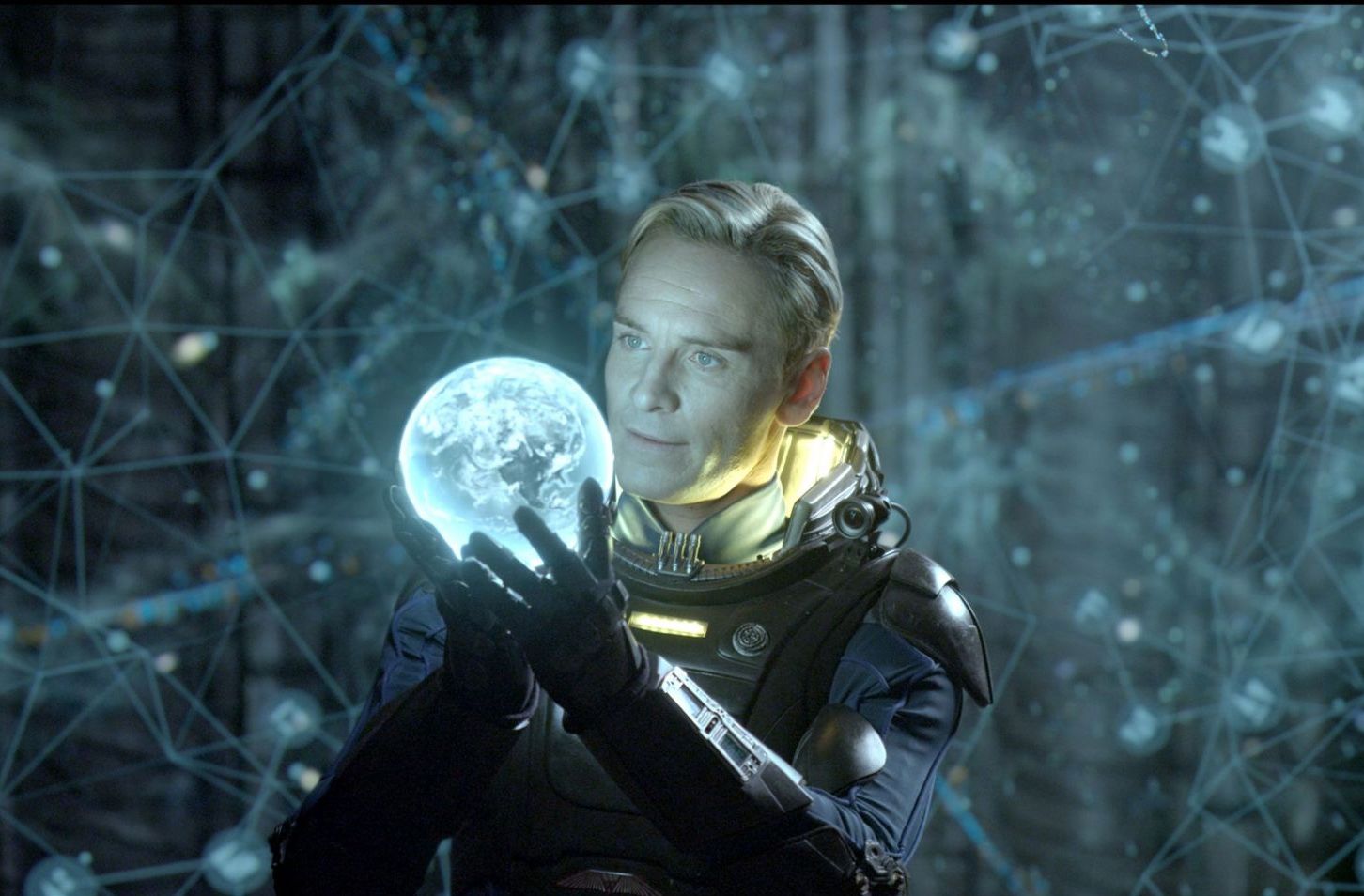
The android David exhibits wonder and surprise at a discovery in a scene from the 2012 sci-fi film “Prometheus.” Image and content ©2012 20th Century Fox, all rights reserved.
Despite these modest advances to date, technology throughout history has often evolved in a hyperbolic pattern after a long, linear period of discovery and research. For example, as the Cambridge scientists pointed out, many people doubted the possibility of heavier-than-air flight. This has been achieved and improved many times over, even to supersonic speeds, since the Wright Brothers’ unprecedented world’s first successful airplane flight. In last year’s sci-fi epic “Prometheus,” the android David is an engineered human designed to assist an exploratory ship’s crew in every way. David anticipates their desires, needs, yet also exhibits the ability to reason, share emotions and feel complex meta-awareness. Forward-reaching? Not possible now? Perhaps. But by 2050, computers controlling robot “brains” will be able to execute 100 trillion instructions per second, on par with human brain activity. How those robots order these trillions of thoughts, only time will tell!
If nature can engineer it, why can’t we?
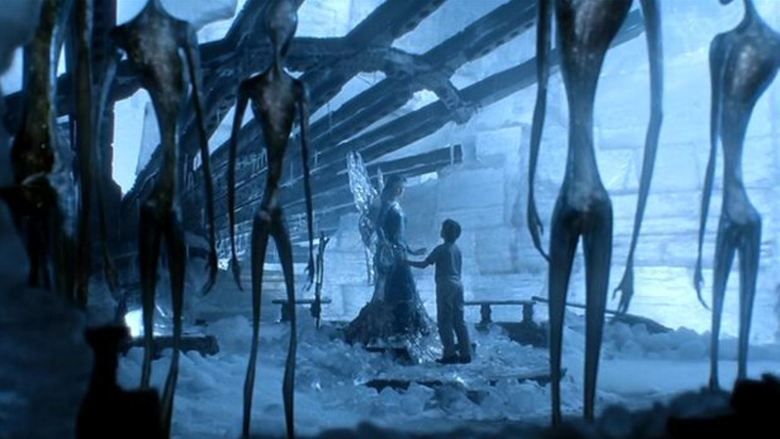
A world dominated by artificial intelligence in a scene from Stephen Spielberg’s “A.I.” ©2001 Warner Brothers Pictures, all rights reserved.
The human brain is a marvelous feat of natural engineering. Making sense of this unique organ that makes humans who we are requires a conglomeration of neuroscience, mathematics and physiology. MIT neuroscientist Sebastian Seung is attempting to do precisely that – reverse engineer the human brain in order to map out every neuron and connection therein, creating a road map to how we think and function. The feat, called the connectome, is likely to be accomplished by 2020, and is probably the first tentative step towards creating a machine that is more powerful than human brain. No supercomputer that can simulate the human brain exists yet. But researchers at the IBM cognitive computing project, backed by a $5 million grant from US military research arm DARPA, aim to engineer software simulations that will complement hardware chips modeled after how the human brain works. The research is already being implemented by DARPA into brain implants that have better control of artificial prosthetic limbs.
The plausibility that technology will catch up to millions of years of evolution in a few years’ time seems inevitable. But the question remains… what then? In a brilliant recent New York Times editorial, University of Cambridge philosopher Huw Price muses about the nature of human existentialism in an age of the singularity. “Indeed, it’s not really clear who “we” would be, in those circumstances. Would we be humans surviving (or not) in an environment in which superior machine intelligences had taken the reins, to speak? Would we be human intelligences somehow extended by nonbiological means? Would we be in some sense entirely posthuman (though thinking of ourselves perhaps as descendants of humans)?” Amidst the fears of what engineered beings, robotic or otherwise, would do to us, lies an even scarier question, most recently explored in Vincenzo Natali’s sci-fi horror epic Splice: what responsibility do we hold for what we did to them?
Is it already checkmate AI?

Could large supercomputer capacity, pictured here at the IBM labs, eventually allow artificial intelligence to mimic human brain function?
Computers have already beaten humans hands down in a number of computational metrics, perhaps most notably when the IBM chess computer Deep Blue outwitted then-world champion Gary Kasparov back in 1997, or the more recent aforementioned quiz show trouncing by Watson. There are many reasons behind these supercomputing landmarks, not the least of which is the much quicker capacity for calculations and are not being subject to the vagaries of human error. Thus, from the narrow AI point of view, hyper-programmed robots are already well on their way, buoyed by hardware and computing advances and programming capacity. According to Moore’s law, the amount of computing power we can fit on a chip doubles every two years, an accurate estimation to date, despite skeptics who claim that the dynamics of Moore’s law will eventually have to end. Nevertheless, futurist Ray Kurtzweil predicts that computers’ role in our lives will expand far beyond tablets, phones and the Internet. Taking a page out of The Terminator, Kurtzweil believes that humans will eventually be implanted with computers (a sort of artificial intelligence chimera) for longer life and greater brain capacity. If the researchers developing artificial intelligence at Google X Labs have their say, this day will arrive sooner rather than later.
There may be no i in robot, but that does not necessarily mean that advanced artificial beings would be altruistic, or even remotely friendly to their organic human counterparts. They do not (yet) have the emotions, free will and values that humans use to guide our decision-making. While it is unlikely that robots would necessarily be outright hostile to humans, it is possible that they would be indifferent to us, or even worse, think that we are a danger to ourselves and the planet and seek to either restrict our freedom or do away with humans entirely. At the very least, development and use of this technology will yield considerable novel ethical and moral quandaries.
There may not be much telling what the future of technology holds just yet, but in the meantime, humanity can be comforted by the knowledge that it will be a while before an all-powerful robot crashes the party.
Reese Jones is a tech and gadget lover, a die-hard fan of iOS and console games. She writes about everything from quick tech tips, to mobile-specific news from the likes of O2, to tech-related DIY. Follow her on Twitter and Google+.
*****************
ScriptPhD.com covers science and technology in entertainment, media and advertising. Hire our consulting company for creative content development.
Subscribe to free email notifications of new posts on our home page.
]]>“The wars of the 21st Century will be fought over water.” —Ismail Serageldin, World Bank

Last Call at the Oasis film poster ©2012, Participant Media, all rights reserved.
Watching the devastation and havoc caused by Hurricane Sandy and several recent water-related natural disasters, it’s hard to imagine that global water shortages represent an environmental crisis on par with climate change. But if current water usage habits do not abate, or if major technological advances to help recycle clean water are not implemented, this is precisely the scenario we are facing—a majority of 21st Century conflicts being fought over water. From the producers of socially-conscious films An Inconvenient Truth and Food, Inc., Last Call at the Oasis is a timely documentary that chronicles current challenges in worldwide water supply, outlines the variables that contribute to chronic shortages and interviews leading environmental scientists and activists about the ramifications of chemical contamination in drinking water. More than just an environmental polemic, Last Call is a stirring call to action for engineering and technology solutions to a decidedly solvable problem. A ScriptPhD.com review under the “continue reading” cut.

A man in China hauls two buckets of water during a severe drought. Ongoing, frequent droughts represent a huge threat to China’s agricultural industry.
Although the Earth is composed of 70% water, only 0.7% (or 1% of the total supply) of it is fresh and potable, which presents a considerable resource challenge for a growing population expected to hit 9 billion people in 2050. In a profile series of some of the world’s most populous metropolises, Last Call vividly demonstrates that stark imagery of shortage crises is no longer confined to third world countries or women traveling miles with a precious gallon of water perched on their heads. The Aral Sea, a critical climate buffer for Russia and surrounding Central Asia neighbors, is one-half its original size and devoid of fish. The worst global droughts in a millennium have increased food prices 10% and raised a very real prospect of food riots. Urban water shortages, such as an epic 2008 shortage that forced Barcelona to import emergency water, will be far more common. The United States, by far the biggest consumer of water in the world, could also face the biggest impact. Lake Mead, the biggest supplier of water in America and a portal to the electricity-generating Hoover Dam, is only 40% full. Hoover Dam, which stops generating electricity when water levels are at 1050 feet, faces that daunting prospect in less than 4 years!
One strength of Last Call is that it is framed around a fairly uniform and well-substantiated hypothesis: water shortage is directly related to profligate, unsustainable water usage. Some usage, such as the 80% that is devoted to agriculture and food production, will merit evaluation for future conservation methods. California and Australia, two agricultural behemoths half a world apart, both face similar threats to their industries. But others, such as watering lawns. are unnecessary habits that can be reduced or eliminated. Toilets, most of which still flush 6 gallons in a single use, are the single biggest user of water in our homes—6 billion gallons per day! The US is also the largest consumer of bottled water in the world, with $11 billion in sales, even though bottled water, unlike municipal tap water, is under the jurisdiction of the FDA, not the EPA. As chronicled in the documentary Tapped, 45% of all bottled water starts off as tapped water, and has been subject to over 100 recalls for contamination.

Gravity field anomalies measured through the GRACE Satellite provide information about changes in the Earth’s water levels.
A cohort of science and environmental experts bolsters Last Call’s message with the latest scientific research in the area. NASA scientists at the Jet Propulsion Laboratory are using a program called the Gravity Recovery and Climate Experiment (GRACE) Satellite to measure the change in oceans, including water depletion, rise in sea levels and circulation through a series of gravity maps. Erin Brockovich, famously portrayed by Julia Roberts in the eponymous film, appears throughout the documentary to discuss still-ongoing issues with water contamination, corporate pollution and lack of EPA regulation. UC Berkeley marine biologist Tyrone Hayes expounds on what we can learn from genetic irregularities in amphibians found in contaminated habitats.
Take a look at a trailer for Last Call at the Oasis:
Indeed, chemical contamination is the only issue that supersedes overuse as a threat to our water supply. Drugs, antibiotics and other chemicals, which cannot be treated at sewage treatment plants, are increasingly finding their way into the water supply, many of them at the hands of large corporations. Between 2004 and 2009, there were one half a million violations of the Clean Water Act. Last Call doesn’t spare the eye-opening details that will make you think twice when you take a sip of water. Atrazine, for example, is the best-selling pesticide in the world, and the most-used on the US corn supply. Unfortunately, it has also been associated with breast cancer and altered testosterone levels in sea life, and is being investigated for safety by the EPA, with a decision expected in 2013. More disturbing is the contamination from concentrated animal feeding operations (CAFOs) near major rivers and lakes. Tons of manure from cows, one of which contributes the waste of 23 humans, is dumped into artificial lagoons that then seep into interconnected groundwater supplies.

A scientist holds a bottle of water filtered and purified through reverse osmosis at a sewage recycling plant. Would you drink it?
It’s not all doom and gloom with this documentary, however. Unlike other polemics in its genre, Last Call doesn’t simply outline the crisis, it also offers implementable solutions and a challenge for an entire generation of engineers and scientists. At the top of the list is a greater scrutiny of polluters and the pollutants they release into the water supply without impunity. But solutions such as recycling sewage water, which has made Singapore a global model for water technology and reuse, are at our fingertips, if developed and marketed properly. The city of Los Angeles has already announced plans to recycle 4.9 billion gallons of waste water by 2019. Last Call is an effective final call to save a fast-dwindling resource through science, innovation and conservation.
Last Call at the Oasis went out on DVD November 6th.
~*ScriptPhD*~
*****************
ScriptPhD.com covers science and technology in entertainment, media and advertising. Hire our consulting company for creative content development.
Subscribe to free email notifications of new posts on our home page.
]]>
Official Looper film poster, and all movie stills below, ©2012 Sony Pictures Entertainment, all rights reserved.
In the year 2042, time travel has not yet been invented. But by the year 2072, that is no longer the case. Nevertheless, it is outlawed, inaccessible to all but the most powerful and violent gangs in an economically repressed dystopia. Due to scientific advances of that era, it is impossible to dispose of a body without a trace, so the criminal gangs use the time travel to execute their “trash,” sending the bodies back in time to be executed by hit men called Loopers. The body vanishes from the future, but never existed in the present. Unless something goes terribly awry. Such is the setup of Rian Johnson’s bleak, brilliant sci-fi film Looper, a shrewd commentary on how we use technology, the value of a human life and whether a destiny can be changed. It is easily the best sci-fi film since 2010’s Inception, and surely one of the best of this year in any genre. Full ScriptPhD review, below.

Joe, a looper, about to kill one of his loops in the empty field where bodies show up from the future.
Joe (Joseph Gordon-Levitt) is a Looper, a very desirable and profitable position in a time over-run with vagrant raids, poverty, hopelessness and violence. The job has a 30-year finite time span, at which time the Looper is sent back into time to be exterminated, and a younger, genetically identical version of him starts job all over again. This is called “closing the loop.” The consequences, shown early in the film, of not closing the loop are dire, both for the younger Looper and his older counter-part. But Joe, an emotionally detached junkie, treats his executions with a regimented ennui. Until one day, when a loop fails to show up at the expected hour. In a split second, Joe recognizes the man as the older version of himself (Bruce Willis), and the brief hesitation allows Old Joe to escape, unleashing the fury of the warlords on both of them across the boundaries of time.
The future painted by Johnson is noir-lugubrious but stops short of the over-the-top post-apocalyptic dreariness of Blade Runner or Children of Men. Instead, the issues of social equality, money and humanity that we struggle with today are exaggerated under the umbrella of traditional sci-fi existentialism. The Looper future is also one filled with abject unfairness. Hungry vagrants that steal food out of desperation are shot immediately by armed citizens. A mobster (Jeff Daniels) sent from the future to run the loopers quenches his boredom by running the city with tyranny, leaving the dirty work of closing loops to violent thugs. Worst of
all is the news from the future of the appearance of a tyrannical warlord named The Rainmaker, who is closing all the loops one by one.
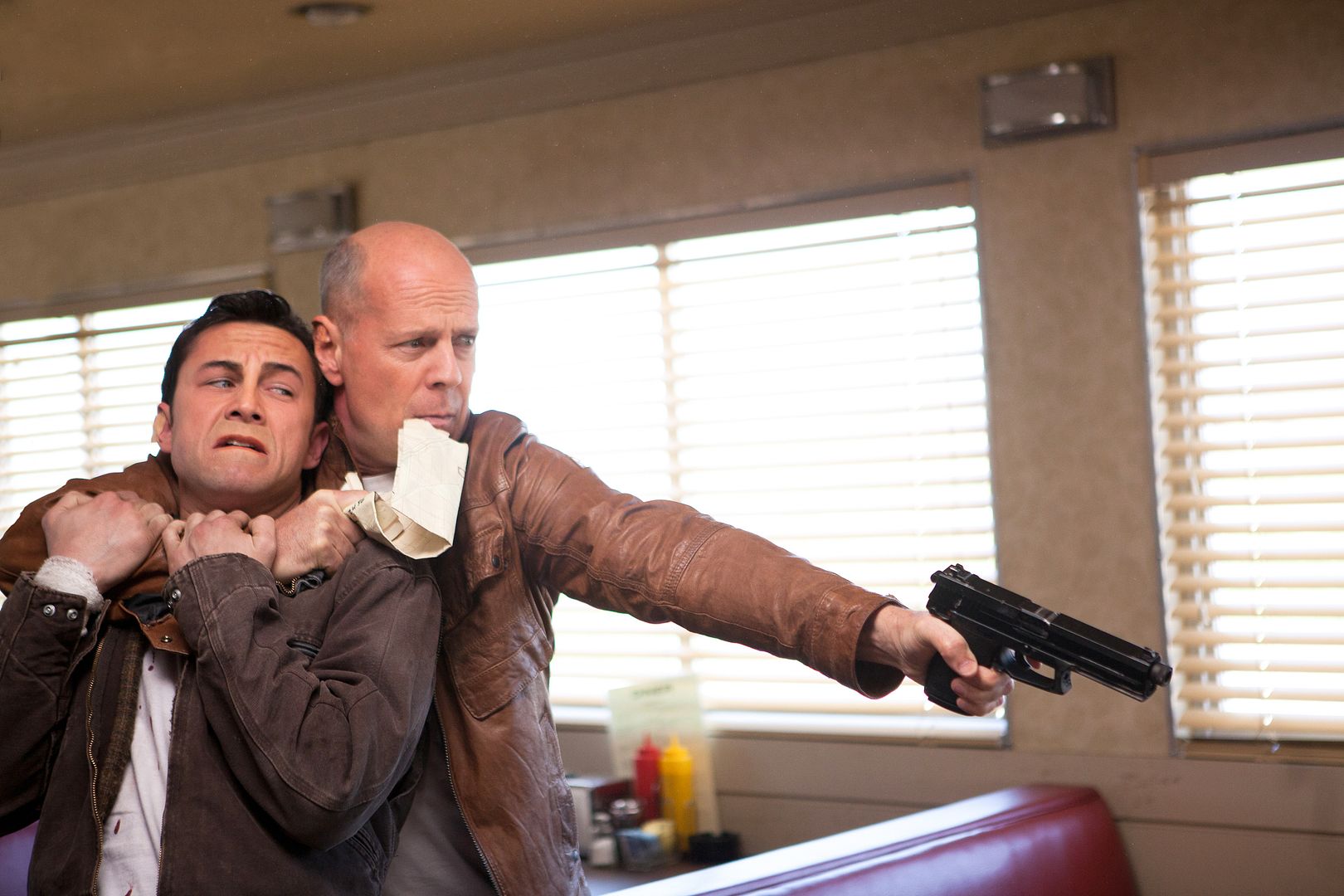
Young Joe and Old Joe in a battle in a scene from “Looper.”
At first, the relationship between Young Joe and Old Joe is antagonistic. All Old Joe wants to do is survive and warn his younger counterpart not to repeat the mistakes he made, especially trying to avoid the death of his wife. All Young Joe wants to do is close his loop, collect the money and make right with the mob. But they grow to grudgingly protect one another amidst a greater goal—finding and eliminating the younger version of The Rainmaker in the present. A series of mysterious maps and codes lead Young Joe to a farmhouse where a young woman, Sarah (Emily Blunt), and her son Cid (Pierce Ganon) are hiding out. As it dawns on Young Joe that Cid is the Young Rainmaker, he wrestles with whether a deleterious future can truly be avoided either for himself or Cid, all while chasing Old Joe and being chased himself.
From the sci-fi element, Looper craftily wedges evolution of technology in a future world not so unlike our own. There is time travel, a quirky genetic mutation that affects 10% of the population (they can levitate quarters!) and expected audiovisual upgrades to touch-screen technology. But there are also familiar elements—books, records, refrigerators and even cars—that make these developments feel natural and real. Even time travel is treated not as an exotic luxury but a quotidian burden. The one and only scene of time travel in the film shows a rather simple metal tube that transports people to a time point in an empty field.
Whether time travel is actually possible in reality is a point of continuing contention with physicists. First referenced in H.G. Wells’s The Time Machine, time travel has been a steady staple of the sci-fi canon, but it wasn’t until Albert Einstein unraveled the four dimensions of space with his Theory of Relativity in 1915 that the notion seemed tenable. And of course, in theory, time travel is a very real occurrence, since we know that time passes more slowly the closer you approach the speed of light. Physicists such as Stephen Hawking have grappled with other time-space phenomena such as wormholes and quantum theory that might facilitate time jumping. Most scientists, however, are unified in their belief that if a time machine were ever built, it would be used exclusively for going forward in time, and not backwards, for many of the same quandaries proposed in Looper, particularly whether you can change the course of events that are destined to happen in the future.

Will we ever be able to travel back in time to warn our younger selves of mistakes? Can the future be altered? These are the questions explored brilliantly in “Looper.”
But Looper doesn’t contend with any of that. It just assumes physicists have solved these hurdles and focuses on a smart, intricate, well-written story. It’s a film that treats its audience with respect, asking for patience in the more complicated plot points, and rewarding it with a satisfying, shocking crescendo worthy of its metaphysical journey. Indeed, Looper might be the first film of the 21st Century to provide a truly real purview into the ethical quandaries, and frightening realities, that time travel might present to us should it ever come to pass.
Preview trailer here:
Looper goes into release nationwide on September 28, 2012.
~*ScriptPhD*~
*****************
ScriptPhD.com covers science and technology in entertainment, media and advertising. Hire our consulting company for creative content development.
Subscribe to free email notifications of new posts on our home page.
]]>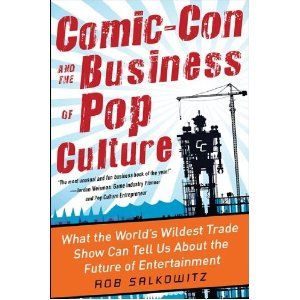
Comic-Con and the Business of Pop Culture ©2012 McGraw Hill Professional, all rights reserved.
This past weekend, over 130,000 people descended on the San Diego Convention Center to take part in Comic-Con 2012. Each year, a growing amalgamation of costumed super heroes, comics geeks, sci-fi enthusiasts and die-hard fans of more mainstream entertainment pop culture mix together to celebrate and share the popular arts. Some are there to observe, some to find future employment and others to do business, as beautifully depicted in this year’s Morgan Spurlock documentary Comic-Con Episode IV: A Fan’s Hope. But Comic-Con San Diego is more than just a convention or a pop culture phenomenon. It is a symbol of the big business that comics and transmedia pop culture has become. It is a harbinger of future profits in the entertainment industry, which often uses Comic-Con to gauge buzz about releases and spot emerging trends. And it is also a cautionary tale for anyone working at the intersection of television, film, video games and publishing about the meteoric rise of an industry and the uncertainty of where it goes next. We review Rob Salkowitz’s new book Comic-Con and the Business of Pop Culture, an engaging insider perspective on the convergence of geekdom and big business.
Comic-Con wasn’t always the packed, “see and be seen” cultural juggernaut it’s become, as Salkowitz details in the early chapters of his book. In fact, 43 years ago, when the first Con was held at the US Grant hotel in San Diego, led by the efforts of comics superfan Shel Dorf, only 300 people came! In its early days, Comic-Con was a casual place where the titans of comics publishers such as DC and Marvel would gather with fans and other semi-professional artists to exchange ideas and critique one another’s work in an intimate setting. In fact, Salkowitz, a long-time Con attendee who has garnered quite a few insider perks along the way over the years, recalls that his early days of attendance were not quite so harried and frantic. The audience for Comic-Con steadily grew until about 2000, when attendance began skyrocketing, to the point that it now takes over an entire American city for a week each year. Why did this happen? Salkowitz argues that this time period is when a quantum leap shift occurred away from comic books and towards comics culture, a platform that transcends graphic novels and traditional comic books and usurps the entertainment and business matrices of television, film, video games and other “mainstream” art. Indeed, when ScriptPhD last covered Comic-Con in 2010, even their slogan changed to “celebrating the popular arts,” a seismic shift in focus and attention. (This year, Con organizers made explicit attempts to explore the history and heritage partially in order to assuage purists who argue that the event has lost sight of its roots.) In theory, this meteoric rise is wonderful, right? With all that money flowing, everyone wins! Not so fast.
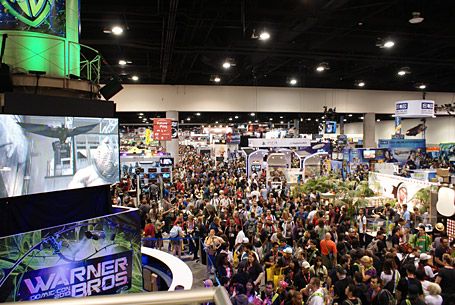
The holy grail of Comic-Con — the exhibit floor, a place of organized chaos where merchants mix with aspiring and current artists, large companies and media empires.
Lost amidst the pomp and circumstance of the yearly festivities is the fact that within this mixed array of cultural forces, there are cracks in the armor. For one thing, comics themselves are not doing well at all. For example, more than 70 million people bought a ticket to the 2008 movie The Dark Knight, but fewer than 70,000 people bought the July 2011 issue of Batman: The Dark Knight. Salkowitz postulates that we may be nearing the unimaginable: a “future of the comics industry that does not include comic books.” To unravel the backstory behind the upstaging of an industry at its own event, Salkowitz structures the book around the four days of the 2011 San Diego Comic-Con. In a rather clever bit of exposition, he weaves between four days of events, meetings, exclusive parties, panels of various size and one-on-one interactions to take the reader on a guided tour of Comic-Con, while in the process peeling back the layers of transmedia and business collaborations
that are the underbelly of the current “peak geek” saturation. A brief divergence to the downfall of the traditional publishing industry, including bookstores (the traditional sellers of comics), the reliance of comics on movie adaptations and the pitfalls of digital publication is a must-read primer for anyone wishing to work in the industry. Even more strapped are merchants that sell rare comics and collectibles on the convention floor. Often relegated to the side corners with famous comics artists so that entertainment conglomerates can occupy prime real estate on the floor, many dealers struggle just to break even. Among them are independent comics, self-published artists, and “alternative” comics, all hoping to cash in on the Comic-Con sweepstakes. Comics may be big business, but not for everyone. Forays into the world of grass-roots publishing, the microcosm of the yearly Eisner Awards for achievement in comics and the alternative con within a Con called Trickster (a more low-key networking event that harkens to the days of yore) all remind the reader of the tight-knit relationship that comics have with their fan base.
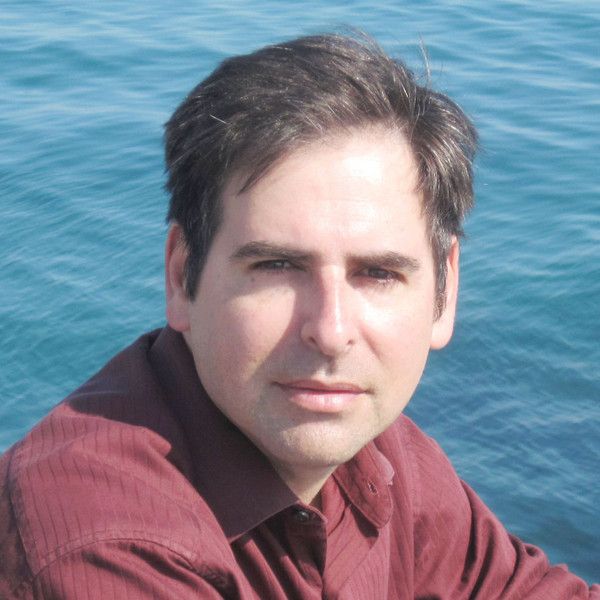
Business and brand expert (and Comic-Con enthusiast) Rob Salkowitz.
In many ways, the comics crisis that Salkowitz describes is not only very real, but difficult to resolve. The erosion of print media is unlikely to be reversed, nor is the penchant towards acquiring free content in the digital universe. Furthermore, video games, represent one of the biggest single-cause reasons for the erosion of comics in the last 20 years. Games such as Halo, Mass Effect, Grand Theft Auto and others, execute recurring linear storylines in a more cost-conscious three-dimensional interactive platform. On the other hand, there are also a myriad of reasons to be positive about the future of comics. The advent of tablets (notably the iPad) represents an unprecedented opportunity to re-establish comics’ popularity and distribution profits. Traditional and casual fans of comics haven’t gone anywhere, they’re just temporarily drowned out by the lines for the Twilight panel. A rising demographic of geek girls represents a potential growth segment in audience. And finally, a tremendous rise in popularity of traditional comics (even the classics) in global markets such as India and China portends a new global model for marketing and distribution. If superheroes are to continue as the mainstay of live-action media, the entertainment industry is highly dependent upon a viable, continued production of good stories. Movies need for comics to stay robust. The creativity and ingenuity that has been the hallmark of great comics continues to thrive with independent artists, some of whose work has gone viral and garnered publishing contracts.

A group of fans gathered outside the San Diego Convention Center to pay homage to the original reason Comic-Con was established!
Make no mistake, comics fans and enthusiastic geeks. Comic-Con and the Business of Pop Culture is very much a business and brand strategy book, centered around a very trendy and chic brand. There’s no question that casual fans and people interested in the more technical side of comics transmedia will find it an interesting, if at times esoteric, read. But for those working in (or aspiring to) the intersection of comics and entertainment, it is an essential read. Cautioning both the entertainment and comics industries against complacency against what could be a temporary “gold rush” cultural phenomenon, Salkowitz nevertheless peppers the book with salient advice for sustaining comics-based entertainment and media, while fortifying traditional comics and their creative integrity for the next generation of fans. The final portion of the book is its strongest; a hypothetical journey several years into the future, utilizing what he calls “scenario planning” to prognosticate what might happen. Comic-Con (and all the business that it represents) might grow larger than ever, an absolute phenomenon, might scale back to account for a diminishing fan interest, might stay the same or fraction into a series of global events to account for the growing overseas interest in traditional comics. Which one will come to fruition depends on brand synergy, fan growth and engagement, distribution with digital and interactive media, and a carefully cultivated relationship between comics audiences, creators and publishers. Salkowitz calls Comic-Con a “laboratory in which the global future of media is unspooling in real time.” What will happen next? Like any good scientist knows, experiments, even under controlled circumstances, are entirely unpredictable. See you in San Diego next year!
Rob Salkowitz is the cofounder and Principal Consultant of Seattle-based MediaPlant LLC and is the author of two other books, Young World Rising and Generation Blend. He also teaches in the Digital Media program at the University of Washington. Follow Rob on Twitter.
~*ScriptPhD*~
*****************
ScriptPhD.com covers science and technology in entertainment, media and advertising. Hire our consulting company for creative content development.
Subscribe to free email notifications of new posts on our home page.
]]>













